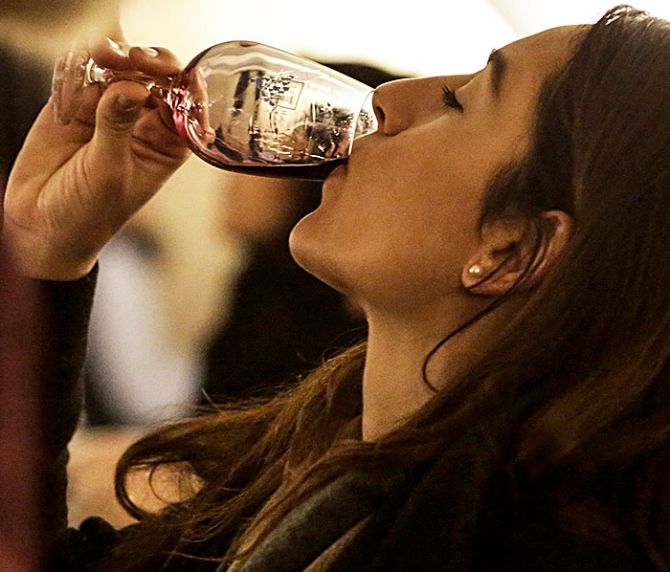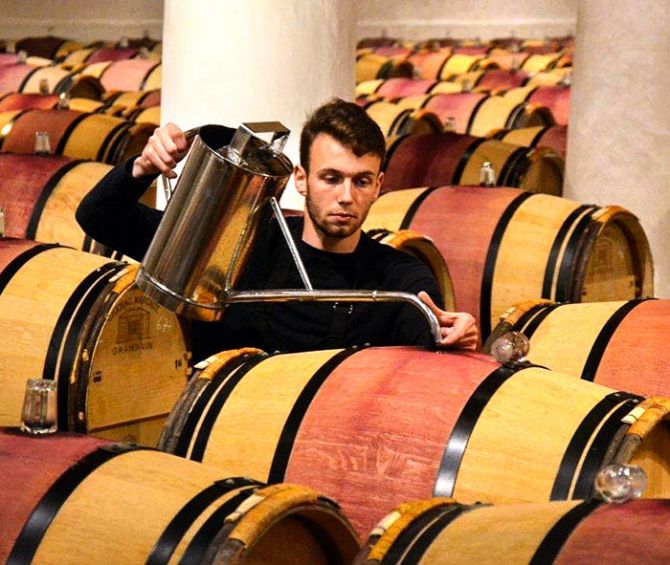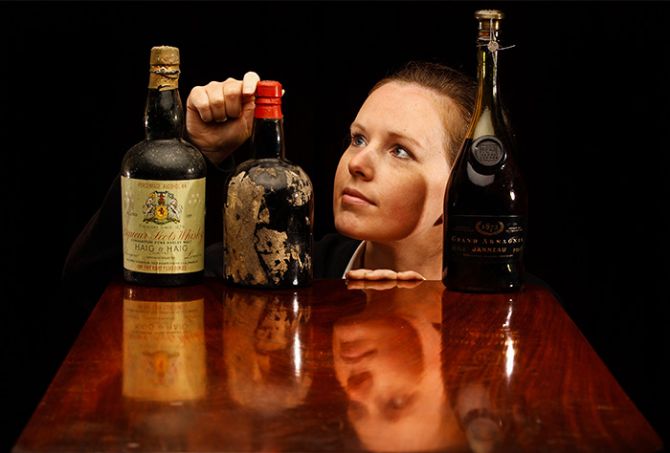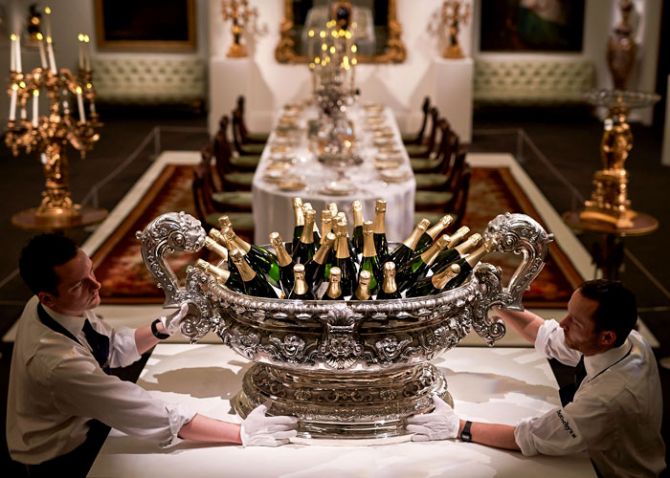Avantika Bhuyan uncorks the business of vintage wines and spirits.

Photograph: Patrick Aventurier/Getty Images.
A few years ago, several dusty bottles of an unknown spirit were discovered in the ancient cellars of Harewood House in Yorkshire.
The owners of the 18th-century country house called in experts from Christie's to assess the find.
The explorations that followed led the auction house team to a cellar book entry dating back to July 1805. It mentioned '226 bottles, dark and light 1780' of a 'cane spirit' stored in two-numbered bins. The description matched the bottles that had been found.
'The rum,' states an article on the Christie's website, 'had been distilled in Barbados, shipped in a barrel to England, and bottled in Harewood. It was the oldest rum Christie's specialists had ever seen.'
Twelve bottles of the rum would later sell for a record £10,000 each.
Till a decade ago, stories such as this would have drawn an appreciative nod and a wistful sigh from Indian wine and spirits enthusiasts, serving as a mere conversation starter.
Today, however, a niche segment of connoisseurs is keeping a lookout for such anecdotes to know exactly which vintage liquor to collect or invest in.
At the forefront of this list of discerning collectors is Singapore-based Ravi Viswanathan.
A wine connoisseur and director of Grover Zampa Vineyards, Viswanathan owns some of the oldest champagnes in the world.
'My oldest yellow wine, or vin jaune, is an 1821 that has had only two owners in history -- the winemakers and their heirs, and now my family,' he says in an email interview.
Viswanathan's collection includes an extensive selection of Chateau Chalon wines from before 1945 and pre-war (1933 to 1939) Burgundies.

Brands such as these have a finite supply of wine, which makes the prices shoot up.
Photograph: @chateaumargaux/Instagram.
Fine wines have now emerged as an alternative commodity investment.
'It is a big thing abroad, but less so right now in India,' says sommelier Magandeep Singh, author of The Indian Spirit: The Untold Story of Drinking in India.
Connoisseurs in India are, however, beginning to wake up to the fact that a fine wine offers returns of 10 to 15 per cent to a conservative investor and more to a speculative one who's not scared of taking risks.
In the past few years, investment in fine wine has taken an organised form in the country with specialist brokerage firms setting up shop here.
One of the first to do so was Bordeaux Traders, which was founded in Vienna in 2009. Three years later, its CEO, Robin Khanna, opened an office in Mumbai to serve Indian investors.
And now there's also All Things Nice, a Mumbai-based consultancy helmed by sommelier Nikhil Agarwal, which offers specialised services in wines, spirits and luxury. The firm has tied up with négociants (wine merchant who sells under his own name) in Bordeaux and fine wine specialists in London.
The universe of collectable and investment-worthy wines does not include those extravagant wines found only in select retail outlets and luxury hotels. These are premium wines the price of which can start at a mere £100 (in London) and then go higher, depending on the vintage and the château.
These liquid nectars primarily hail from producers in Bordeaux, and some from Champagne, Burgundy, Tuscany and the Napa Valley.
'This is a tiny universe comprising wines produced by only a few hundreds of producers globally,' says Agarwal.
Some of these wineries produce only a few thousand cases every year, others even less.
'Take, for example, Château Margaux, considered among the world's best and which was one of the five [wine estates] to achieve the first growth status in the Bordeaux Classification of 1855. It can't simply double the production if the demand spikes,' Agarwal explains. 'Brands such as these have a finite supply.'
As that supply dips, the prices shoot up.

The universe of collectable and investment-worthy wines is not about extravagant wines found only in select retail outlets and luxury hotels.
These are premium wines the price of which can start at a mere £100 and primarily hail from Bordeaux, Champagne, Burgundy, Tuscany and the Napa Valley.
Photograph: Max Rossi/Reuters.
The common perception is that the older the wine, the better it is. But that is a myth.
Most wines are meant to be consumed within a few years of being bottled. But not fine wines; they're not meant to be quaffed young. They are the ones that improve as they age, and some of them are not meant to be had till, say, 10 years of vintage.
'Someone needs to hold on to these wines till then. That's how an investment trade has developed around them,' says Agarwal, who handles the wine investment portfolios of high net worth Indians based in the country and abroad.
One of them is the CEO of a multinational company who started investing in wine while he was heading operations in India.
Today, négociants invest in the wine even before the château puts it into a bottle. When the wine starts getting close to its peak drinking age, its demand too peaks -- as does its price.
Aspiring investors are advised to consult the fine wines listed on Liv-ex, a United Kingdom wine trading exchange that started in 2012, and then enlist the help of a brokerage firm.
Agarwal advises investors to buy different vintages from different regions. Most investors and collectors prefer wines from the Cru Classe classifications in Bordeaux, and not necessarily the First Growths like Haut-Brion, Lafite, Latour, Mouton and Margaux.
Investments typically start at ₹2 lakh for a case of 12 bottles and can go up to millions of dollars.

Photograph: Augusto Mendes/Lehtikuva/Reuters.
Experts would, however, like to make a distinction between collecting a fine wine and investing in it.
The former is driven more by personal palate and sentiment -- say, someone was born in the year of a vintage or someone had a great experience at the château.
Investment, simply, is to turn a profit.
'A collector will keep the bottle in his cellar, while the investor buys and sells like shares, sometimes without even seeing the wine,' says Singh.
Agarwal concurs.
Rather than bring the wines to India, which has some of the highest custom duties and excise taxes in the world, the wines are bought and sold internationally. These wines are stocked at bonded warehouses internationally, ready to be bought and sold on behalf of investors at best prices.
Besides availing of the services of brokerage firms, an investor needs to have a thorough understanding of the category before deciding to put his or her money into fine wines.
'Investing in wine requires a deep knowledge of the wine market and vintages, combined with an idea of how price elasticity works in the context of wines and other fine beverages,' says sommelier Singh.
Finally, one has to know the provenance and also the storage and selling options before buying in.
Viswanathan has a word of caution for investors.
A wise investor, he says, should focus on the really rare wines such as the top Burgundies.
'The drawback and irony of it is that wine is a fairly liquid asset with large transaction costs,' he says. 'You really need to have a passion to collect it' or invest in it.
While the society of fine wine collectors is a secret one, with most keeping their cellars away from prying eyes, some collections, such as Viswanathan's, have over time acquired a significant status for the thought that has gone into building them.
'I am mostly attracted by the vintages and the history [of the wine].'
He does not buy a wine simply to collect it; he buys it to uncork it at a special occasion.

A rare whisky is a luxury product in short supply because aged whiskies are not easily available.
Photograph: Jeff J Mitchell/Getty Images.
Like fine wines, rare whiskies and other spirits too are beginning to draw collectors and investors.
A rare whisky is a luxury product in short supply because aged whiskies are not easily available.
'Because of this high demand and short supply, the acceptance and appreciation of non-aged whiskies by marquee brands has gone up,' says Sandeep Arora, whisky ambassador, collector and founder of Spiritual Luxury Living, a luxury spirits and whisky management company.
Unlike other spirits, he says, an unopened bottle of whisky or cognac do beautifully over time -- the former remaining unspoiled for at least 90 years.
There are three kinds of bottles that people like to collect.
First, a bottle created to mark a special occasion.
An example of this, says Arora, is the Glenfiddich 1976 Concorde Bottling, released to commemorate Concorde's first ever commercial flight on January 21, 1976. Encased in a wooden box, this is considered a rare possession.
Then there is the Diamond Jubilee by the Johnnie Walker unit of Diageo, which was made to mark the 60th year of Queen Elizabeth II's reign and was on sale in Singapore for $198,500 a bottle.
The second is the limited-edition category, such as the Eich Bhana Lir -- a 46-year-old Islay single malt that marks the oldest release to date from Bunnahabhain. Released in July 2017, there are only 198 bottles of it available globally.
'The third category is bottles that have a compelling story,' says Arora.
The brands realise this emotional connect and position the rare spirits accordingly. Some are marketed to convey the personal touch of the creator -- such as the 50-year-old single malt Scotch whisky, priced at £50,000, by Highland distillery Dalmore to celebrate master distiller Richard Paterson's 50 years on the job, and the Glenmorangie private editions like Bacalta, which are inspired from the cabinet of curiosities of Bill Lumsden, the master distiller.

Whether it is for collecting or investing, what matters most is provenance, and the best way to ensure that you land a genuine bottle is through a sale by a reputed auction house.
Photograph: Michael Bowles/Getty Images.
The fine interest sometimes also comes with the promise of unique after-sales service.
Penfolds, one of Australia's oldest wineries, for instance, has been organising wine clinics since 1991 where it assesses the health of the wine in the possession of collectors. The only condition is that the bottle should be a Penfolds red and should be at least 15 years old.
So far, Penfolds experts have assessed over 1,50,000 bottles from across four continents.
'The clinics [held every two years] are free to attend,' says Samuel Stephens, Penfolds wine-making ambassador.
Whether it is for collecting or investing, what matters most is provenance, and the best way to ensure that you land a genuine bottle is through a sale by a reputed auction house such as Christie's or Sotheby's.
In fact, wines and spirits is one of the most active departments at Christie's whose first-ever auction in 1766 included wines.
'Landmark wine sales include wines direct from the private cellar of Henri Jayer, rarities from the cellars of Château Latour and The Collection of Henry Tang, which were all 100 per cent sold wine auctions,' says Tim Triptree, senior specialist (wine department) and director, Christie's.
Indian collectors say they are keeping a lookout for rare and vintage wines from Charles Heidsieck at an upcoming auction in December in London and New York, where the champagnes on offer go back to the 1966 vintage.
Being released specifically for this sale, these have been slowly maturing in the ideal conditions of the Charles Heidsieck Crayères, or chalk cellars.
Sotheby's, too, has been expanding its wine category since its first sale in Scotland on September 16, 1970. It now holds regular wines sales in New York (since 1994) and Hong Kong (since 2009) and London (since 1970).
'It seems astonishing to see how popular wine auctions have become and how prices have risen into the stratosphere when you look back to the first sale in 1970, which made £25,000,' says Jamie Ritchie, worldwide head, Sotheby's Wine.
Sotheby's global wine auction sales in 2016 totalled $74 million, a 22 per cent increase on the 2015 figure of $60.4 million.
And more and more Indians, he says, are raising a toast at these auctions.











 © 2025
© 2025